Inverter for solar panels: types of devices, model overview, connection features
Solar systems around the world are developing at a tremendous pace. The International Energy Agency in its annual report noted that in 2016 the number of commissioned solar power plants for the first time exceeded the number of coal.
The heart of the solar energy system is an inverter for solar panels, the task of which is to transform a constant type of current into alternating current. We will tell you how to choose the best option for the device and how to correctly install it. Based on our recommendations, you can assemble an impeccably functioning mini-power station.
The content of the article:
Types of inverters for solar panels
Without an inverter, the energy produced by the solar system will be completely useless for domestic needs. There are 3 types of inverters by type of use:
- autonomous;
- network
- multifunctional.
Inverters of the first type are designated “off grid”. They are connected to the solar module, are part of a separate photovoltaic system and do not in any way contact with an external electrical network. Their power varies between 100 - 8000 watts.
Synchronous or network inverters operate synchronously with a centralized power supply system. Converters with the designation “on grid” not only perform the role of a converter, but also correct such network parameters as amplitude differences, frequency indicators, and others.
If there is a problem in the external network, the inverter will automatically shut down. Such inverters accumulate electricity in batteries.
If the total power of the devices used in the house is less than the potential of a solar power station, then excess generated electricity goes into external electric networks. If the power is not enough for the normal operation of household appliances, then recharge from the outside is carried out.
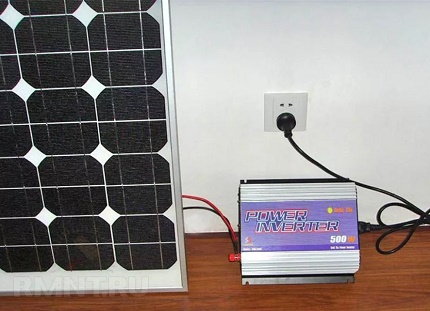
In the absence of voltage, power is supplied from a charged battery. In the case when batteries are not included in the system, the energy produced by the solar power plant goes into a common network.
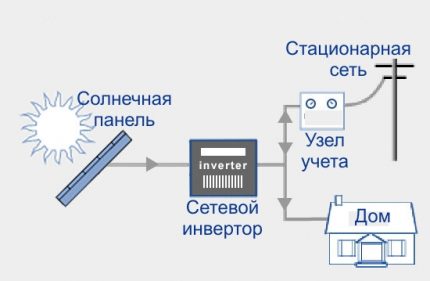
Hybrid or multifunction inverter - reliable equipment. It combines the properties of the first two converters, has a large number of settings. This is the best option for building a home solar station, but also the most expensive.
All existing solar inverters are divided into types and according to the output voltage. Depending on this parameter, they are sinusoidal and meander. Since the first value of the output voltage is almost the same as that of the power supply network, this is a good option when there is a highly sensitive technique in the house.
The constant voltage value is a guarantee of safety for home electrical equipment. Graphically, the waveform at the output of such a sinusoidal inverter is depicted as a pure sine wave.
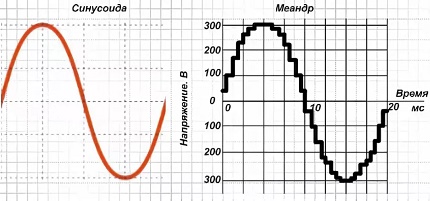
Meander or non-sinusoidal converters, unlike sinusoidal ones, have a signal geometry at the output in the form of rectangular pulses, the so-called modified sine.Inverters of this type cannot be used for individual types of load, but for devices using the active component of power, they are quite suitable.
Inverter selection criteria
When choosing such a solar system element as an inverter, not only the geometry of the output signal, but also its power is important. Experts advise staffing solar panels converters whose rated power is higher than the total power available in the equipment volume, by 25-30 percent.
It is also necessary to take into account the load arising from the simultaneous switching on of several devices with high starting power.
Another criterion when choosing an inverter is its efficiency, which determines the energy loss of the accompanying processes. Depending on the model, it has a different value, which is in the range of 85-95%. The best choice is an efficiency of at least 90%.
Inverters are both single-phase and three-phase. The former are of lower cost, but their choice is justified when the power consumption is less than 10 kW. The voltage they have is 220V, and the frequency is 50Hz. Three-phase inverters have a wider voltage range - 315, 400, 690V.
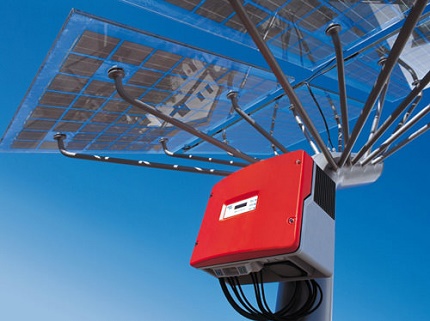
The number of inverters in the system may also be different. The following recommendations should be guided in this matter: if the power of solar panels does not exceed 5 kW, then one inverter is enough for such a system. Higher power batteries may require 2 or more inverters. It is optimal when one inverter is needed for every 5 kW.
For work in a network combining the use of standard electricity and energy supplied by solar panels, apply hybrid inverters. The features of the device and the rules for their selection will be introduced by our recommended article.
Converters can differ from each other in circuits, output signal geometry, and other determining quantities. Separate converters are equipped with chargers. If one of the inverters fails, the system will not stop its operation.
Features of connecting the inverter
The efficiency of the entire solar system depends on the correct connection of the solar inverter. The main thing is to observe the rule: a cable that transmits direct current must have a minimum permissible length and a maximum cross section.
If the consumer is far from solar cells, extend by increasing the electric cable transporting alternating current 220 V. The length of the wire between the inverter and the solar panel should vary within 3 m and not more.
The best option when the inverter is located near solar cell. Particularly stringent conditions have to be met when connecting inverters that exceed 0.5 kW in power.
The wire connection must be solid, as insufficiently tight connection causes sparking, which can cause a fire. When installing an autonomous inverter to ensure uninterrupted power supply to the facility, the DC circuit must be equipped circuit breakers.
The best solution when connecting the inverter is to use hybrid strapping for both direct and alternating current. The principle is based on a special order of turning on the converter. It includes controller for solar panels after the batteries are charged.
This solution increases the quality of the equipment. In regions where electricity is often turned off, or in houses located in areas where cloudy weather prevails, this option works very efficiently.
Overview of Inverter Models
Converters for solar panels are produced by many manufacturers, both domestic and foreign. All equipment has different characteristics, quality levels, its own set of functions and technical capabilities.
Inverters from a domestic manufacturer
A wide range of these products with a power of 800 - 1200 W is produced by the Russian manufacturer MAP "Energy".
The company produces several lines of inverters:
- Sine wave inverters with a pure sine waveform - MAP SIN.
- Sine-wave converters with the function of selecting an additional amount of energy from batteries - MAP HYBRID.
- Three-phase inverters - MAP HYBRID 3 phases.
Inverters manufactured by this company can charge all types of batteries. For this they have Charger high power.
The achievement of the company is a record power inverter - 20 kW, withstanding the largest load of 25 kW. This model can provide reliable power to a large residential building with many appliances.
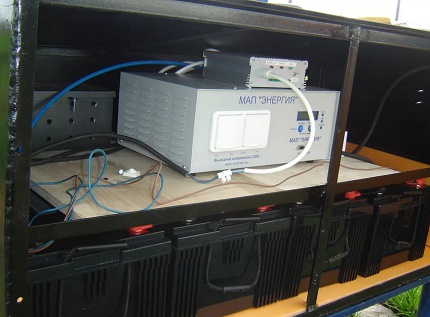
Schneider Electric Conext Converters
The French company Schneider Electric produces inverters with high performance characteristics that allow them to be used in different climates.
The coating of the body, which has high corrosion resistance, allows you to successfully pass testing with salt fog. They are designed for solar panels installed on the roofs of private cottages and apartment buildings.
The manufacturer checks the reliability of his equipment using various methods and tests. The design of Conext inverters lacks electrochemical capacitors, which is a guarantee of long operation.
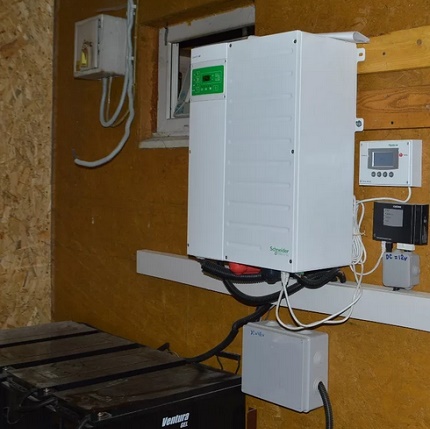
A wide range of products allows you to choose the right model for solar systems with a capacity of 3 - 20 kW.
TBS Electronics Inverters
This Dutch company, which has been present on the market since 1996, produces both low-power and more powerful sinusoidal converters for Poversine solar panels with a rated power of 175 to 3500 watts.
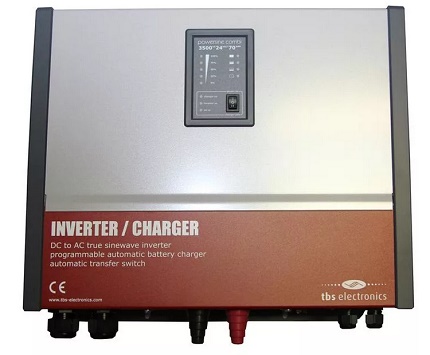
The Powersine line is characterized by a very pure sine wave at the output, so the use of these inverters guarantees the competent and long-term operation of highly sensitive devices. The equipment is equipped with protection against short-circuit, temperature surges, overloads. With these inverters, loads up to 500V can be launched with a starting force that exceeds tens of times the rated power.
Kostal Network Inverters
The company produces innovative high-quality inverters with a capacity of 1.5 to 20 kW, both single and three-phase. The design includes an AC switch that works automatically, MPP trackers, monitor, S0 counter and many other options in the basic configuration. All this makes it possible to introduce an inverter into the "smart home" system.
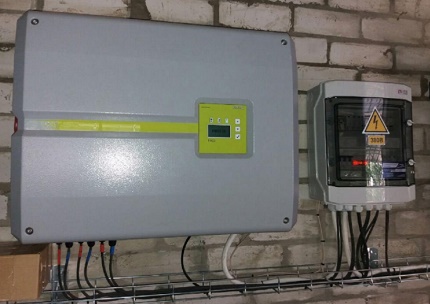
Due to the high quality of the housing material, the converter is installed both outside and inside the house. The assembly is carried out in Europe, so the quality meets European standards. Manufacturer's warranty - 5 years.
ABi-Solar Inverters from Taiwan
These inverters, manufactured in Taiwan, are represented in our market by a series of autonomous SL / SLP converters, autonomous network hybrid inverters (NTR), and the NT hybrid line.
Autonomous converters are equipped with solar charge controllers. This equipment is endowed with triple functionality - it works as an inverter, controller, charger.
The design includes a liquid crystal display that allows you to control the main parameters of the solar system. The efficiency of SL / SLP inverters is about 93%. The SLP models have dust protection.
The inverter from the new ABi-Solar HTP series belongs to the budget option. It works only with a battery. The NT series is particularly popular, including single and 3-phase hybrid inverters, distinguished by excellent build quality.
Converters SL0912 and SL1524 are also low-cost. They work in 2 modes - household uninterruptible and with solar panels. They have 2 modes of voltage maintenance: from 180 to 260V and from 100 to 300V.
The second mode allows you to increase the battery life due to less use, but can only power equipment that is not very sensitive to the quality of electricity.
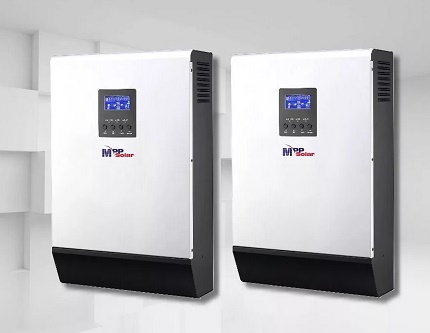
ABi-Solar inverters provide an opportunity to increase the operating temperature range batteries and automate the charge-discharge process.
GoodWE Network Inverters
This Chinese company produces network inverters of different capacities and delivers them to the market at a low price. A special program is attached to the inverter, which allows you to calculate the solar system, taking into account the location of the solar panels in relation to the cardinal points and other landmarks.
It is possible to monitor the operation of the converter via a tablet or smartphone, but first you will have to install an application specially designed for this based on the Android operating system.
Conclusions and useful video on the topic
Here the manager of the selling company talks about the principles of choosing an inverter:
This video highlights the inverter connection issue:
The photoelectric network inverter, as an integral part of the solar system, allows you to get complete independence from centralized power supply and rising prices for electric carriers.
Smart systems, including a network converter, make the process of energy consumption affordable, reliable and manageable. At the same time, comfort in the house is not violated.
Want to tell how you built your own mini-power station with an inverter for solar batteries? Do you have valuable information on a topic that may be useful to site visitors? Please write comments in the block below, post photos and ask questions.

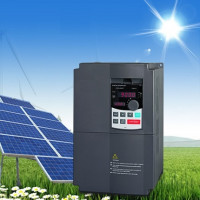 Hybrid inverter for solar panels: types, overview of the best models + connection features
Hybrid inverter for solar panels: types, overview of the best models + connection features  Connection diagram for solar panels: to the controller, to the battery and to the serviced systems
Connection diagram for solar panels: to the controller, to the battery and to the serviced systems 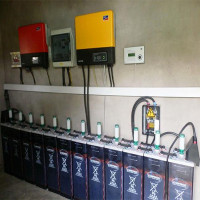 Solar batteries: an overview of the types of suitable batteries and their features
Solar batteries: an overview of the types of suitable batteries and their features 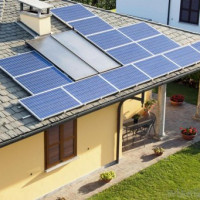 Types of solar panels: a comparative overview of designs and tips for choosing panels
Types of solar panels: a comparative overview of designs and tips for choosing panels 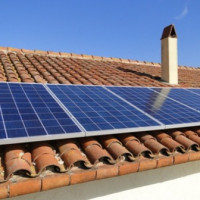 Schemes and methods of connecting solar panels: how to properly install the solar panel
Schemes and methods of connecting solar panels: how to properly install the solar panel 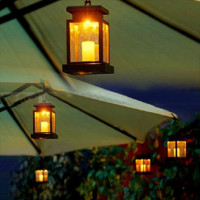 Solar-powered streetlights: views, manufacturers overview and comparison
Solar-powered streetlights: views, manufacturers overview and comparison  How much does it cost to connect gas to a private house: the price of organizing gas supply
How much does it cost to connect gas to a private house: the price of organizing gas supply  The best washing machines with dryer: model rating and customer tips
The best washing machines with dryer: model rating and customer tips  What is the color temperature of light and the nuances of choosing the temperature of the lamps to suit your needs
What is the color temperature of light and the nuances of choosing the temperature of the lamps to suit your needs  Replacement of a geyser in an apartment: replacement paperwork + basic norms and requirements
Replacement of a geyser in an apartment: replacement paperwork + basic norms and requirements
The law of equilibrium in action. To get free energy, the equipment is fabulously expensive. These are photocells, and inverters, and batteries. Their short life should also be considered. But nevertheless, we will gradually switch to renewable sources anyway - we simply have no choice.Of the inverters, I would choose the products of the company Conext. Due to the durability of the work.
With the development of technology, the price will decline. Plus, in some countries there are subsidies for the purchase of environmental alternative energy sources. In Russia, this is only being discussed.
Good day. We are going to put panels at home and can not decide on the choice. I read about Huawei here, and friends advise. But somehow we do not really trust this company, their brand phones constantly broke (I understand, perhaps, not quite a correct comparison, but still). Are they good in this niche? I would be grateful for any answer.